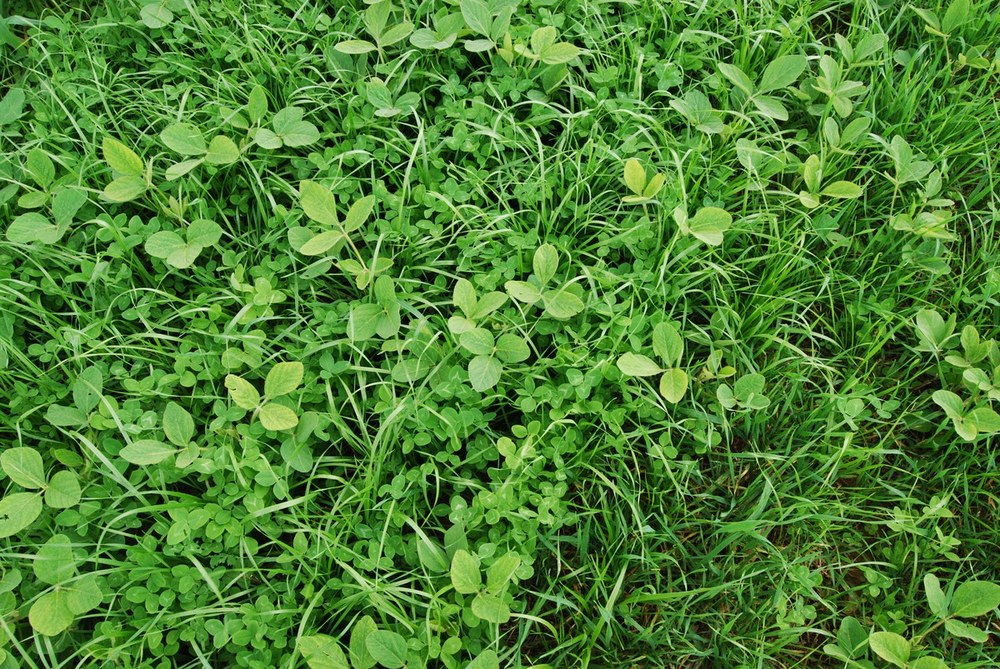We are evaluating cropping systems that reduce synthetic nitrogen inputs and pollution outputs from row crop fields. We monitor nitrogen availability to crops and measure soil greenhouse emissions and subsurface nitrogen leaching to evaluate pollution losses.

Current research compares cover crop monocultures to diverse mixtures like the soybean, rye grass, red clover mix shown here.
We are working on a variety of projects that evaluate nitrogen pollution losses from agroecosystems. In all of these experiments, the goal is to design systems that have low pollution outputs but retain high yield and economic viability. When possible, we take advantage of long-term cropping systems trials that account for cumulative treatment effects over many crop rotations. We also seek to use nitrogen cycling knowledge and ecological theory from unmanaged ecosystems to guide agroecosystem design (Finney et al. 2015; Finney and Kaye 2017; Isbell et al. 2021).
A centerpiece of our research in agroecosystems is a long-term organic cropping systems trial we established in 2011 and is ongoing today. This experiment tests how the selection of cover crop species for monocultures and diverse mixtures can enhance an array of ecosystem services in a corn-soybean-wheat cash crop rotation that produces organic feed and forage. We are designing cover crop mixtures that target improved nutrient supply, nutrient retention, weed suppression, and management ease. Our research station results, combined with results from farmer-collaborators, suggest that species selection and mixture design can have a large impact on ecosystem services, and that the value of mixtures (relative to monocultures) depends on farmer goals. Often monocultures or simple (biculture, triculture) mixtures are sufficient to provide an array of services (Schipanski et al. 2014; Finney et al. 2017; Finney et al. 2016).
The cover crop diversity experiment has given farmers basic information on how different cover crop species grow in our region in monoculture and mixtures (Murrell et al. 2017; Baraibar et al. 2020). It has also informed policies for nitrogen management in the Chesapeake Bay by documenting how cover crop species selection affects nitrogen leaching reduction (Kaye et al. 2019). Charlie White has led development of nitrogen decision support tools that enable farmers to account for cover crop and soil organic matter nitrogen mineralization, which helps farmers adjust synthetic fertilizer or manure inputs to match corn demand (White et al. 2017, 2020).
Over time, the cover crop diversity experiment has become a hub for interdisciplinary agroecology research, with discoveries in areas far beyond the original focus. For a few examples, we have found that cover crop species selection can affect cash crop yield (Hunter et al. 2019), weeds (Baraibar et al. 2018), mycorrhizae-mediated maize pest defenses (Stratton et al 2022, Murrell et al. 2019), soil fungal communities (Cloutier et al. 2020), root distribution in soil (Amsili and Kaye 2020), soil carbon sequestration (Zhang et al. 2022), insect pests (Davidson-Lowe et al. 2021), and crop pathogens (Ray et al. 2022). Microbiologists have used the site to evaluate soil innocula for diversifying microbial communities and recovering soil functions (King et al. 2022, 2023). Graduate students from many disciplines have used the site for dissertation research and as the basis for successful graduate fellowship proposals.
Another theme in our agricultural research has been climate change. We have studied interseeding (planting cover crops into living cash crops; Isbell et al. 2022, Wallace et al. 2021) as an innovative cover cropping strategy that may be easier to implement as heavy rains become more common and soil cover is essential. We reviewed how cover crops can help mitigate climate change by increasing surface albedo and reducing greenhouse gas emissions through reduced fertilizer use and enhanced soil carbon sequestration (Kaye and Quemada 2017). We have shown that crop rotation choices, cover crop species, and manure management can have large effects on soil-to-atmosphere N2O (a potent greenhouse gas) emissions (Adviento-Borbe et al. 2010, Morris et al. 2021, Saha et al. 2021).
Forthcoming research will include expanded measurements of soil N2O emissions and microbial control on the production of N2O. We are also expanding the applicability of nitrogen decision support tools through new studies of soil texture effects on microbial carbon use efficiency. In our cover crop diversity experiment, future research will focus on improved mixture design for enhancing root-derived ecosystem services. And, in a major transition, we will convert half of the plots to a rotation that includes perennial crops in a diversity gradient intended to improve soil health.
The Kaye Biogeochemistry Lab believes that everyone should have equal access to science, and we strive to create an environment that welcomes and respects diversity in all its forms—including cultural, racial, religious, age, gender identity, sexual orientation, physical ability, and mental wellbeing. Read more here.
The Kaye Biogeochemistry Lab believes that everyone should have equal access to science, and we strive to create an environment that welcomes and respects diversity in all its forms—including cultural, racial, religious, age, gender identity, sexual orientation, physical ability, and mental wellbeing. Read more here.

